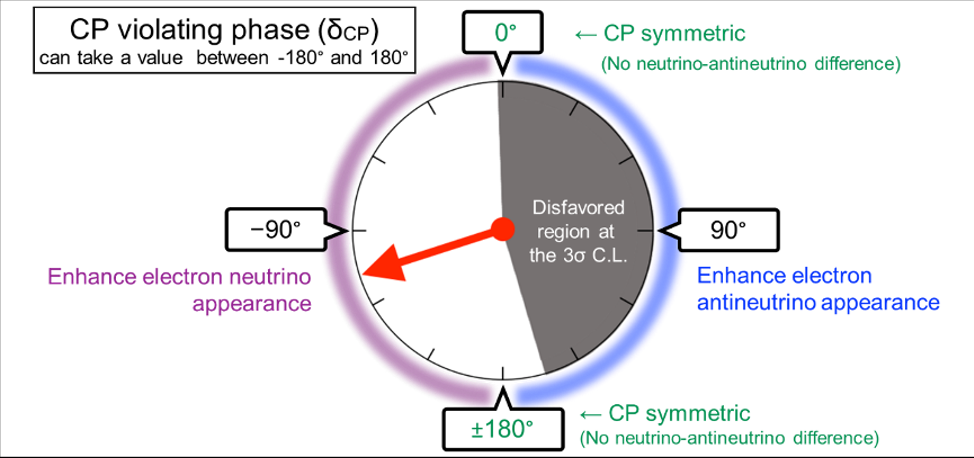News & Events
April 20, 2020
New T2K Experiment Results
We congratulate the T2K experiment on their recent results. This work (see below for more details!) is looking for possible matter-antimatter asymmetries by constraining differences in the neutrino and antineutrino oscillation rates. These differences are given by the parameter δCP, and T2K’s recent results have excluded nearly half of the possible values for this parameter. These early results suggest that indeed there may be a difference between how regular neutrinos and antineutrinos oscillate. If so, this could be related to the mystery behind why there is so much matter in the universe compared to antimatter.

Figure 1 from the paper showing the new constraints and best estimates for the δCP parameter.
T2K: The Tokai to Kamioka experiment
What is it:
T2K (Tokai to Kamioka) is a long-baseline neutrino experiment in Japan that is studying the fundamental nature of neutrinos. T2K was initially proposed in 2003, started taking data in 2010, and is made up of over 500 physicists and engineers and has over 60 research institutes involved, including several across Canada. T2K sends a beam of neutrinos from Tokai on the east coast of Japan, 295 km across Japan, until arriving on the west coast at a detector in Kamioka.

Figure 2: A diagram showing the trajectory of the T2K beam across Japan.
What are neutrinos?
Neutrinos are elementary particles that come in three “flavours”: electron, muon, and tau. They only interact through the weak force and are very difficult to detect as they rarely interact with matter. Electron neutrinos are produced in large numbers in the Sun, and solar neutrinos can pass through the Earth without interacting. Dr. Arthur B. McDonald with the Sudbury Neutrino Observatory (SNO) collaboration co-won the 2015 Physics Nobel Prize for demonstrating that neutrinos of one flavour will change into other flavours along their journey. This process is known as neutrino oscillation and directly implies that neutrinos have mass, something that is not possible in the standard model of particle of physics. Thus, this exciting process requires scientists to fix some unknown error in the theoretical backbone of this field.
What’s the matter?
Now that we understand that neutrinos do have mass, we can ask many interesting questions to give insights into the unknown problems in the theory. The first is what are the masses? We know neutrinos come in three different mass states, but we don’t know their actual mass values. Another is whether neutrinos and antineutrinos behave differently and if this could explain why there is more matter in the universe than antimatter. The recent T2K results apply to this topic of matter/antimatter differences.

Figure 3: An image of the Super Kamiokande detector in Kamioka. Each dot in this image is a large sensor very sensitive to tiny bursts of light that occur when a neutrino interacts with the water in the detector. An example of these light sensors is available in the McDonald Institute Visitor Centre.
How are they studying this?
Because we understand how a neutrino changes its flavour along its journey, we can place a detector a certain distance from a neutrino source to study that oscillation. T2K is specifically designed so that the detector, 295 km away from the source of a muon neutrino beam, should see a large fraction of these neutrinos arriving having oscillated into electron neutrinos. The scientists are finding the fraction of electron neutrinos present when they are using a muon neutrino beam, and the fraction of electron antineutrinos present when they are using a muon antineutrino beam. If there is a difference in these fractions, then that would suggest a difference between how regular neutrinos and antineutrinos behave.
The result:
By analyzing data from up to 2018, the T2K experiment has found that there does seem to be a difference between the oscillation fraction depending on whether matter or antimatter beams are used. Given this, they can rule out some possible values of the δCP parameter with 99.7% confidence. More data will further constrain this value.
